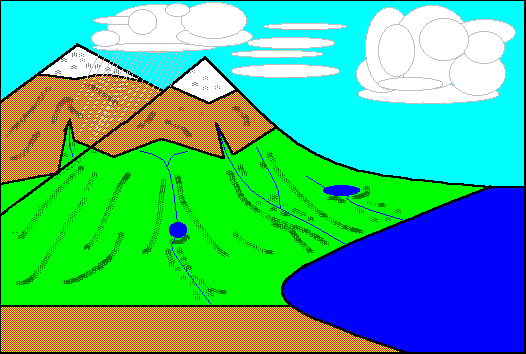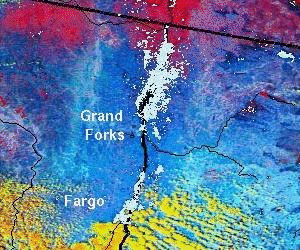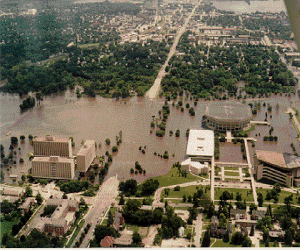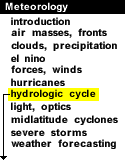
|

Animation by: Bramer
Runoff is the movement of landwater to the oceans, chiefly in the form of rivers, lakes, and streams. Runoff consists of precipitation that neither evaporates, transpires nor penetrates the surface to become groundwater. Even the smallest streams are connected to larger rivers that carry billions of gallons of water into oceans worldwide.
Excess runoff can lead to flooding, which occurs when there is too much precipitation. Two recent events in the United States have caused major flooding.

|
Northern Plains Flooding March-May 1997 In early spring of 1997, the Northern Plains endured devastating floods. Towns along the Red River like Grand Forks, North Dakota were shut down due to flooding that completely paralyzed the city, leaving entire downtown areas underwater. Floodwater is shown here in white while unmelted snow is shaded red. |
During the Fall of 1996, towns along the Red River received record amounts of rain. In the winter, a cold air outbreak froze the water before it could runoff, and the record rainfall was followed up by record amounts of snow. Snow continued to pile up during the long winter and once temperatures finally warmed up, the melting began. However, not only did the snow from the winter melt, but also the frozen rainwater from the previous Fall season. As it turned out, there was too much water for local streams and the Red River to handle, and consequently, the entire area flooded.
River levels rose to as much as 27 feet above flood stage! Large pieces of floating ice blocked the flow of the river, forcing it out of its banks and into nearby residences and businesses.

|
Midwest Flooding June-August 1993 During the summer of 1993, over 20 inches of rain fell upon many locations in the Midwest, with localized amounts exceeding 33 inches. The excessive amounts of rain severely affected shipping, agriculture, and human lives. This photo was taken in Ames, Iowa when the flood waters reached their maximum. |
An analysis of atmospheric conditions for the summer of 1993 showed a stationary high pressure system, also known as the Bermuda High, centered much closer to the United States than normally observed for that time of year. This allowed unusual amounts of warm moist air to be transported northward from the Gulf of Mexico and into the central portion of the country. This moisture-rich air fueled showers and thunderstorms that brought significant amounts of rain to many regions of the Midwest. Precipitation totals were so large and of such extended duration that normal means of surface water removal (transpiration, groundwater, and runoff) were inadequate. Rivers doubled, even quadrupled in size, as nearby towns succumbed to the floodwaters.

transpiration |
|

summary |



